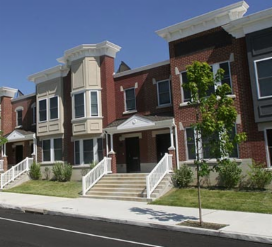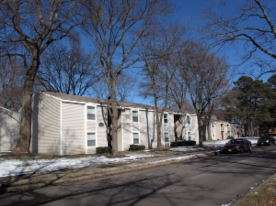 The federal Community Reinvestment Act (CRA), enacted in 1977, charges federal bankingregulators to ensure that banks, “serve the credit needs of their local communities in a safe and sound manner.” In order to meet CRA requirements, banks have invested considerably in low-income housing tax credit (LIHTC) properties over time. However, in recent years the location of bank deposits has become an increasingly important factor in determining where banks must make their equity commitments. This trend has caused tax credit pricing to be much higher in major urban areas where deposits are heavily concentrated, like New York City and San Francisco.
The federal Community Reinvestment Act (CRA), enacted in 1977, charges federal bankingregulators to ensure that banks, “serve the credit needs of their local communities in a safe and sound manner.” In order to meet CRA requirements, banks have invested considerably in low-income housing tax credit (LIHTC) properties over time. However, in recent years the location of bank deposits has become an increasingly important factor in determining where banks must make their equity commitments. This trend has caused tax credit pricing to be much higher in major urban areas where deposits are heavily concentrated, like New York City and San Francisco.
Federal bank agencies have recently sought to reform CRA regulations, particularly by expanding the concept of CRA assessment areas and published new proposed interpretive guidance in March 2013. Based on comments from more than 200 organizations, changes were incorporated into the final version of the guidance, published in the Federal Register on November 20, 2013.
As published in the January issue of the Tax Credit Advisor, Matt Barcello and Fred Copeman of CohnReznick, LLP, believe that under the new guidance, banks will have the option of investing in LIHTC projects in other areas within the same state or the same region. For example, a bank whose CRA footprint is in the New York City area, which tries, to no avail, to find a local LIHTC project, should be able to invest in a project in upstate New York and receive CRA credit for that investment. As Barcello and Copeman point out, this change might not reduce credit pricing in CRA “hot” markets, but it could take pressure off banks to bid up pricing for projects within their footprint. In order for this change to materialize, banking regulators will need to revise the training of their CRA examiners, which the industry is currently awaiting.
For the latest on investment trends in the low-income housing tax credit industry, contact us at Steve Spall (sspall@tcamre.com) and Allen Feliz (afeliz@tcamre.com) — (617) 542-1200.



 Through 2013 it appears that as long as Fannie Mae and Freddie Mac remain in business, they will continue to lend to affordable housing, particularly to existing and aging affordable developments. By the end of 2013, Fannie and Freddie were on pace to match the prior year’s affordable production lending volume. For Freddie, this meant $3 billion in affordable housing loans and for Fannie, $3.4 billion.
Through 2013 it appears that as long as Fannie Mae and Freddie Mac remain in business, they will continue to lend to affordable housing, particularly to existing and aging affordable developments. By the end of 2013, Fannie and Freddie were on pace to match the prior year’s affordable production lending volume. For Freddie, this meant $3 billion in affordable housing loans and for Fannie, $3.4 billion.
 On February 11, 2014, one of our clients, the
On February 11, 2014, one of our clients, the 
 The U.S. Department of Housing and Urban Development (HUD) recently launched the RentalAssistance Demonstration (RAD) program to address a $25 billion accumulation in capital needs for public housing. The nation loses approximately 10,000 public housing units every year; an additional 40,000 apartments are at-risk of losing their subsidies and being removed from the public housing inventory. HUD developed RAD in large part to preserve these at-risk assets and other publicly assisted-developments.
The U.S. Department of Housing and Urban Development (HUD) recently launched the RentalAssistance Demonstration (RAD) program to address a $25 billion accumulation in capital needs for public housing. The nation loses approximately 10,000 public housing units every year; an additional 40,000 apartments are at-risk of losing their subsidies and being removed from the public housing inventory. HUD developed RAD in large part to preserve these at-risk assets and other publicly assisted-developments.


 From January 14th – 17th, hundreds of developers, capital providers, housing agency membersand other professionals in the affordable housing industry met in Washington DC for the NCSHA Housing Finance Agency Conference. The conference featured speeches and panel discussions from the industry’s leading experts.
From January 14th – 17th, hundreds of developers, capital providers, housing agency membersand other professionals in the affordable housing industry met in Washington DC for the NCSHA Housing Finance Agency Conference. The conference featured speeches and panel discussions from the industry’s leading experts.
 The rate at which LIHTC projects generate tax credits will float according to a present-value formula based on the federal cost of borrowing, which has been low since the economic downturn and credit crisis. The floating rate is often more than a full percentage point below 9 percent. However, the rate has recently been about 7.6 percent. According to Affordable Housing Finance online (
The rate at which LIHTC projects generate tax credits will float according to a present-value formula based on the federal cost of borrowing, which has been low since the economic downturn and credit crisis. The floating rate is often more than a full percentage point below 9 percent. However, the rate has recently been about 7.6 percent. According to Affordable Housing Finance online (
 The leadership of the appropriations committees are currently discussing how to divide the FY2014 $1.012 trillion spending cap among the 12 appropriations subcommittees. Appropriators are expected to release in early January an omnibus bill with a mix of new appropriations bills for some federal agencies and a continuing resolution (CR) for the others. If the relevant House and Senate subcommittees are able to reach agreement on their respective FY 2014 funding bills, those bills will likely be incorporated in a larger omnibus spending bill. If there is not agreement, programs within their jurisdictions would likely be funded under a long-term CR.
The leadership of the appropriations committees are currently discussing how to divide the FY2014 $1.012 trillion spending cap among the 12 appropriations subcommittees. Appropriators are expected to release in early January an omnibus bill with a mix of new appropriations bills for some federal agencies and a continuing resolution (CR) for the others. If the relevant House and Senate subcommittees are able to reach agreement on their respective FY 2014 funding bills, those bills will likely be incorporated in a larger omnibus spending bill. If there is not agreement, programs within their jurisdictions would likely be funded under a long-term CR.